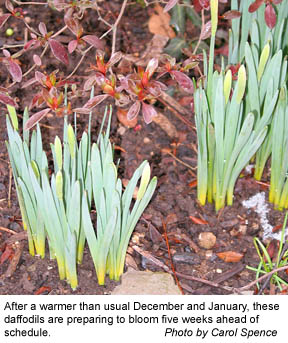Our Warm Winter: What’s to Complain About?
Our Warm Winter: What’s to Complain About?

While much of the country buckles under an onslaught of a nasty-tempered Old Man Winter, Kentuckians are downright basking in what is turning out to be a much warmer than normal season. But unseasonably warm weather in December and January is not always a good thing. Gardeners, knowing that there’s still the chance for frigid temperatures, may be eyeing their landscapes with some trepidation as woody plants display premature buds and spring bulbs push out new growth weeks early.“Protecting plants in situations like this is kind of like protecting spring flowering shrubs from those frosts that will inevitably happen,” said Rick Durham, University of Kentucky Cooperative Extension consumer horticulture specialist. “Is it worthwhile to expend a lot of effort to save a few flowers, whereas the plant is probably going to be okay in the long run?”Durham indicated that interest in global warming may make people more conscious of varying weather trends. But looking back over history, this type of weather pattern occurs occasionally.Though there may be some limbs that die back or get damaged, Durham doesn’t expect any permanent damage to plants in general. However, there are some steps gardeners can take in response to plant stress, with the first one being simply to give the plant time.Before plunging into the yard with pruning shears, ready to attack anything that looks as if it died over the winter, assess the situation. Don’t automatically assume that things are dead. Some plants may awaken earlier than usual and have their leaf buds zapped by a cold snap. This does not necessarily spell doom for the plant. Though one set of buds may be killed by frost, the tree or shrub has other sets in reserve. The next stretch of warm weather will see new buds emerge. Allow woody plants the time to leaf out fully before pruning. Some shrubs or trees may even break dormancy a little later than normal this year. So what looks like dead wood may still be dormant. Green tissue under the bark is a good indicator that everything is normal with the tree or shrub. Breaking a twig or scratching the bark with a fingernail can expose that inner tissue. Plants rely on different stimuli to come out of dormancy. Day length and temperature are factors. Warmer weather tends to bring things out of dormancy. However, some plants have a built in safeguard against early warm weather. They have to accumulate what is known as “chilling requirements;” they must experience a certain amount of cold before they’ll break dormancy. So a plant exposed to warm weather in early January without satisfying its chilling requirement would be much slower to resume growth than a plant in mid-March that has had its chilling requirement satisfied. If the gardener does see a lot of damage in the spring, Durham also recommends fertilization to encourage new growth and help plants rebound. Wait until woody shrubs and trees have broken dormancy before fertilizing them. Spring flowering bulbs should be fertilized when the growth is emerging from the soil.This year, that bulb growth may be happening earlier than usual. In that case, Durham said caution is advised when fertilizing emerging spring perennials around woody plants, because it might stimulate growth in other things. A water soluble fertilizer can be directed to just the plants that need it.The warm winter means that gardeners may also see an increase in disease in their woody plants in the upcoming growing season, said John Hartman, UK plant pathologist. Some of the Prunus species, such as cherries, peaches and plums, including the ornamental varieties, may see winter injury as a result of the weather being warm and then turning cold suddenly. That type of injury opens the door for canker diseases to move in.Two diseases, peach leaf curl and plum pockets, invade buds just as they’re beginning to swell. Because many of these trees’ buds have begun to swell earlier than usual, Hartman predicted that the fungi that cause those two diseases have already invaded the plants.“People who depended on putting a spray on during the dormant season are probably too late at this time,” he said. “Even though they haven’t emerged, the buds did swell a little bit (in the warm weather) and that’s all it took. … We’ll see a bit more of those two diseases, but they’re relatively minor diseases.”All in all, the mild winter may push our gardens slightly ahead of schedule, but there’s really nothing to worry about. Plants often come with their own built-in safe guards against variations in weather conditions.“It’s amazing how nature has adapted,” Durham said.
